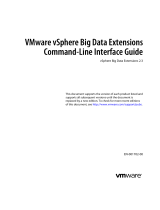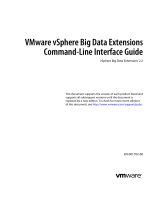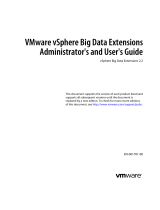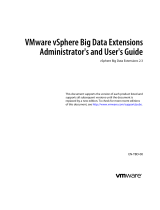Page is loading ...

The Elephant in the Room
Quy Ta 23 Mar 2015
This blog will explore a hybrid computing environment that takes Lustre®, a high performance parallel file system and integrates
it with Hadoop®, a framework for processing and storing big data in a distributed environment. We will explore some reasons
and benefits of such a hybrid approach and provide a foundation on how to easily and quickly implement the solution using
Bright Cluster Manager® (BCM) to deploy and configure the hybrid cluster.
First, let’s establish some definitions and technologies for our discussion. Hadoop is a software framework for distributed storage
and processing of typically very large data sets on compute clusters. The Lustre file system is a parallel distributed file system
that is often the choice for large scale computing clusters. In the context of this blog, we define a hybrid cluster as taking a
traditional HPC cluster and integrating a Hadoop computing environment capable of processing MapReduce jobs using the
Lustre File System. The hybrid solution that we will use as an example in this blog was jointly developed and consists of
components from Dell, Intel, Cloudera and Bright Computing.
Why would you want to use the Lustre file system with Hadoop? Why not just use the native Hadoop file system, HDFS?
Scientists and researchers have been looking for ways to use both Lustre and Hadoop from within a shared HPC infrastructure.
This hybrid approach will allow them to use Lustre as both the file system for Hadoop analytics work as well as the file system
for their general HPC workloads. They can also avoid standing up two different clusters (HPC and Hadoop), and the associated
resources required, by allowing the re-purposed provisioning of the existing HPC cluster resources into a small to medium sized
self-contained Hadoop cluster. This solution would typically target those HPC users that have a need to run periodic Hadoop
specific jobs.
A key component to connecting the Hadoop and Lustre ecosystems is the Intel Hadoop Adapter for Lustre plug-in or Intel HAL
for short. Intel HAL is bundled with the Intel Enterprise Edition for Lustre software. It allows the users to run MapReduce jobs
directly on a Lustre file system. The immediate benefit is that Lustre is able to deliver faster, stable and easily managed storage
for the MapReduce applications directly. A potential long term benefit using Lustre as the underlying Hadoop storage would be a
higher raw capacity available when compared to HDFS due to the three time replication as well as the performance benefits of
running Lustre on InfiniBand connectivity. The following architectural diagram will illustrate a typical topology for the hybrid
solution.

The following will be a high level recount of how we easily implement the solution using the BCM tool to deploy and configure.
The first thing we did was to establish an optimized and fully functional Lustre environment. For this solution, we used the Dell
Storage for HPC with Intel Enterprise Edition (EE) for Lustre software as the Lustre solution, Cloudera CDH as the
Hadoop distribution and Bright Cluster Manager (BCM) as the imaging and cluster deployment tool.
Using the Intel Manager for Lustre (IML) GUI interface, we verified the MDT and OST objects are healthy and in an optimal
state. We also verified that the LNet interface and the Lustre Kernel modules are loaded and Lustre NIDS are accessible.
Verify contents of /etc/modprobe.d/iml_lnet_module_parameters.conf are correct for each MDS and OSS server. Example below.
[root@boulder_mds1 ~]# cat /etc/modprobe.d/iml_lnet_module_parameters.conf
# This file is auto-generated for Lustre NID configuration by IML
# Do not overwrite this file or edit its contents directly
options lnet networks=o2ib0(ib0)
### LNet Configuration Data
## {
## "state": "lnet_unloaded",
## "modprobe_entries": [

## "o2ib0(ib0)"
## ],
## "network_interfaces": [
## [
## "10.149.255.250",
## "o2ib",
## 0
## ]
## ]
## }
[root@boulder_mds1 ~]#
Using the IML GUI, verify status of MDT and OST objects. There should be no file system alerts and all MDT and OST objects
should have green status.
Configuration > File Systems > Current File Systems > “lustrefs”

Verify that UIDs and GIDs are consistent on Lustre clients. This must be done before installing Hadoop software. In particular,
the following users and groups should be checked:
users: hdfs, mapred, yarn, hbase, zookeeper
groups: hadoop, zookeeper, hbase
We used the following script to set up our Hadoop users prior to installing Hadoop:
VALUE=10000;
for i in hive hbase hdfs mapred yarn;
do

VALUE=$(expr $VALUE + 1);
groupadd -g $VALUE $i;
adduser -u $VALUE -g $VALUE $i;
done;
groupadd -g 10006 hadoop;
groupmems -g hadoop -a yarn;
groupmems -g hadoop -a mapred;
groupmems -g hadoop -a hdfs;
usermod -d /var/lib/hive -s /sbin/nologin hive;
usermod -d /var/run/hbase -s /sbin/nologin hbase;
usermod -d /var/lib/hadoop-yarn -s /sbin/nologin yarn;
usermod -d /var/lib/hadoop-mapreduce -s /sbin/nologin mapred;
usermod -d /var/lib/hadoop-hdfs -s /bin/bash hdfs
As a sanity check, we verified the nodes we wanted to re-provision as Hadoop nodes that were able to read/write to the Lustre
file system.
Once we verified all the pre-requisite items above and established that we had a working Lustre environment, we proceeded with
the following steps to build, configure and deploy the Hadoop nodes that mount and use the Lustre file system.
Steps we took to build the hybrid solution:
1) Created a software image ‘ieel-hadoop’ using BCM. You can clone an existing software image.
2) Created a node category ‘ieel-hadoop’ using BCM. You can clone an existing node category.
3) We assigned the selected nodes to be provisioned as Hadoop nodes to the ieel-hadoop node category.
4) Installed Cloudera CDH 5.1.2 and the Intel Hadoop Adapter for Lustre (HAL) plug-in into the ieel-
hadoop software image.
5) We installed the Intel EE for Lustre client software onto the ieel-hadoop software image.
6) We prepared the Lustre directory for Hadoop on the ieel-hadoop software image.
Example:
#chmod 0777 /mnt/lustre/Hadoop
#setfacl –R –m group:hadoop:rwx /mnt/lustre/hadoop

#setfacl –R –d –m group:hadoop:rwx /mnt/lustre/hadoop
7) Added the Lustre file system mount point to the ieel-hadoop node category for automatic mounting upon
bootup.
Example: 192.168.4.140@tcp0:192.168.4.141@tcp0:/lustre /mnt/lustre lustre defaults,_netdev 0 0
8) We added several tuning parameters to /etc/sysctl.conf in the ieel-hadoop software image.
Example:
lctl set_param osc.*.max_dirty_mb=512
lctl set_param osc.*.max_rpcs_in_flight=32
/








